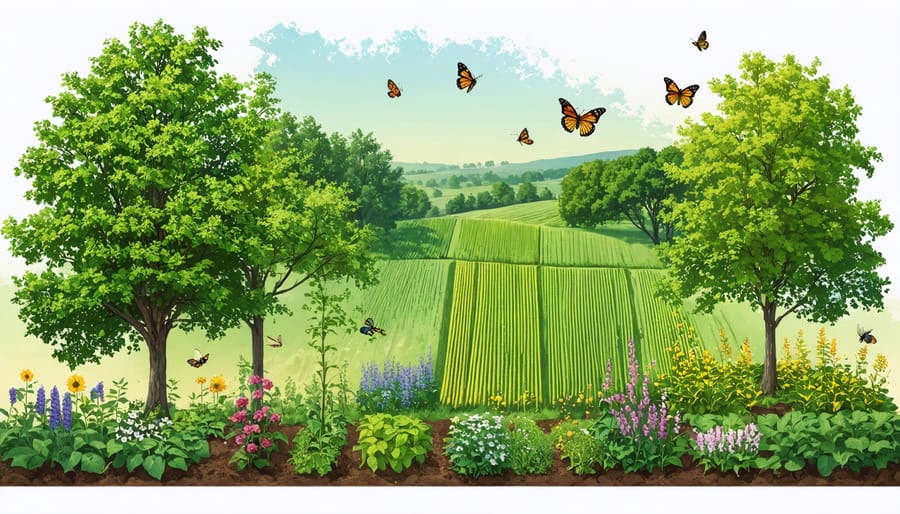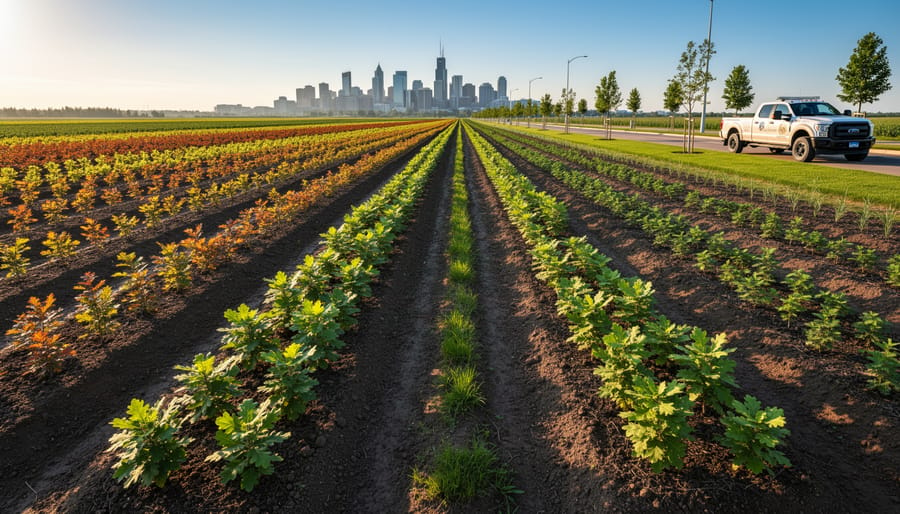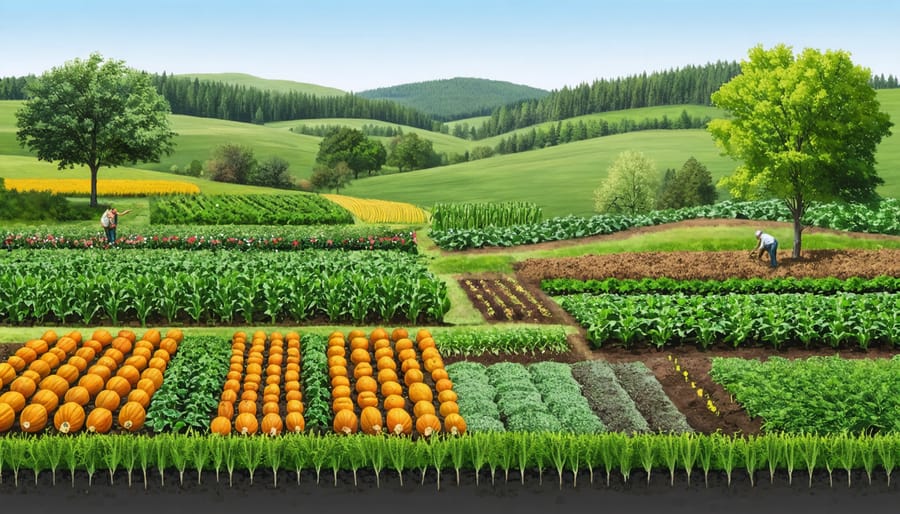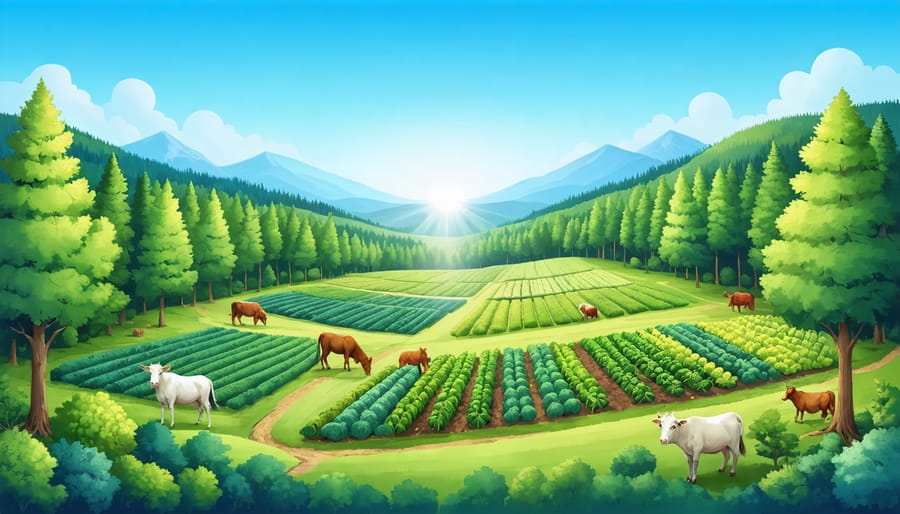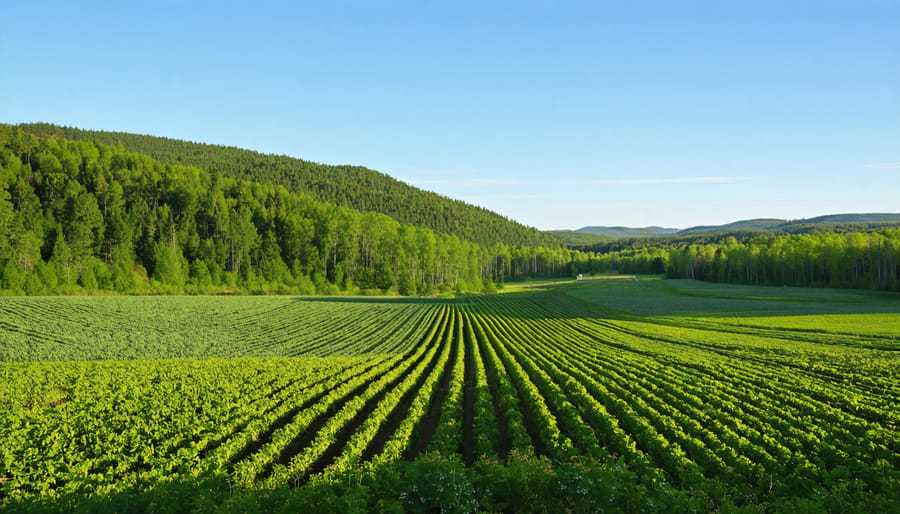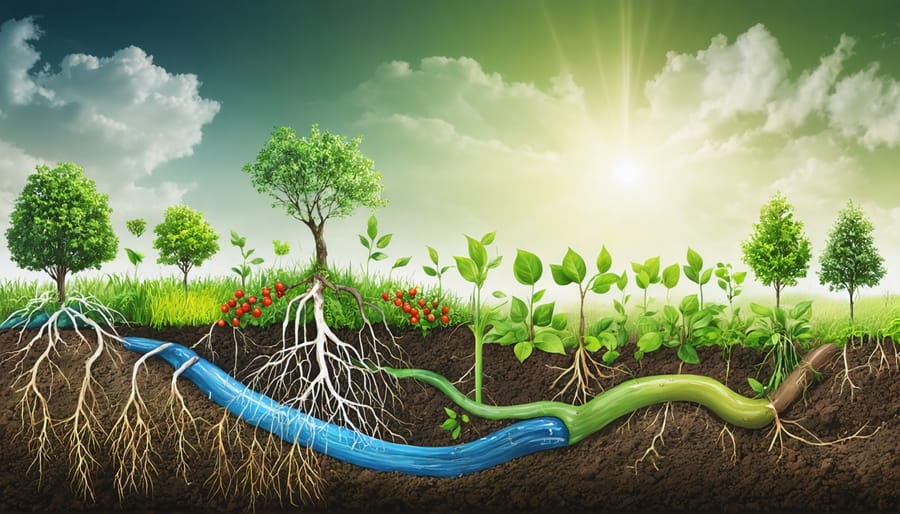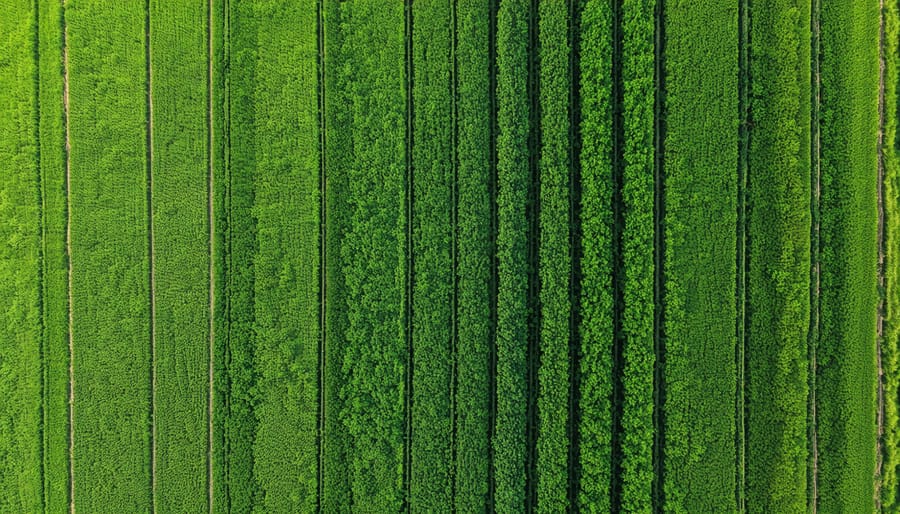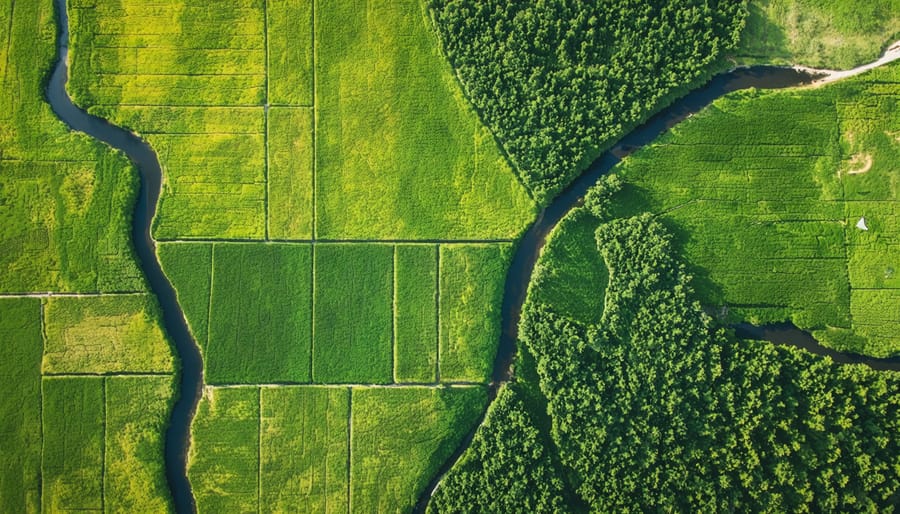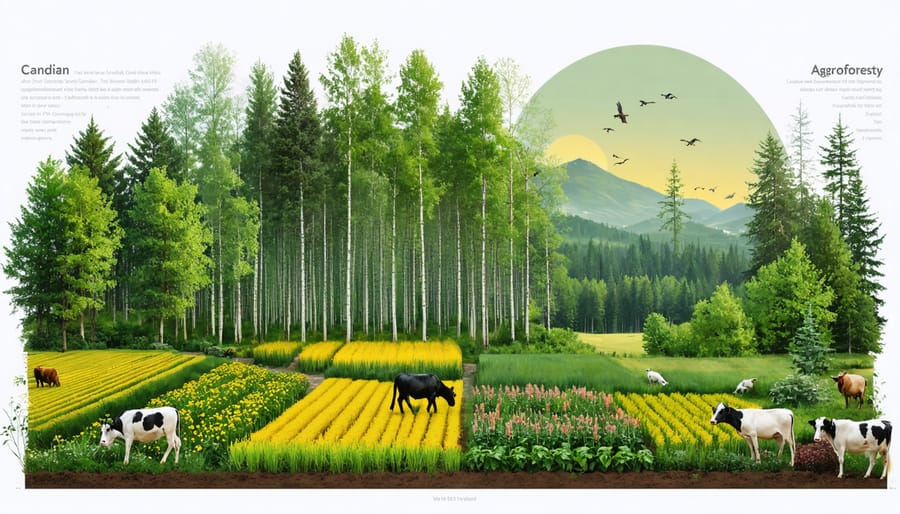Transform your farmland into a thriving ecosystem by implementing climate-resilient agroforestry systems that boost crop yields while supporting native pollinators. Strategic integration of trees and shrubs alongside traditional crops creates natural windbreaks, reduces soil erosion, and provides essential habitat for beneficial insects. Canadian farmers who adopt agroforestry practices report up to 30% increased pollination rates and enhanced crop diversity, particularly in Alberta’s challenging climate conditions. By combining food production with sustainable forestry, these systems deliver multiple revenue streams while building long-term environmental resilience. Recent studies from the Prairie Farm Rehabilitation Administration demonstrate that properly designed agroforestry systems can increase farm productivity by 40-60% compared to conventional monoculture practices, while simultaneously reducing water consumption and enhancing soil organic matter. This proven approach to agricultural innovation offers Canadian farmers a practical path toward economic stability and ecological sustainability.
Natural Pollinator Habitats Through Strategic Tree Integration
Native Tree Species That Attract Local Pollinators
Alberta’s native tree species play a crucial role in supporting local pollinators while providing significant biodiversity benefits to agroforestry systems. The Manitoba Maple (Acer negundo) offers early-season nectar that’s essential for native bee populations, while the Saskatoon berry (Amelanchier alnifolia) provides both food for pollinators and a valuable crop for farmers.
Chokecherry (Prunus virginiana) trees are particularly effective at attracting diverse pollinator species, including native bees, butterflies, and beneficial wasps. Their spring blossoms create a crucial nectar source, while their fruit supports bird populations that contribute to natural pest control.
Balsam Poplar (Populus balsamifera) and Trembling Aspen (Populus tremuloides) serve as host plants for various butterfly species and provide essential habitat for native bees. These fast-growing trees also offer wind protection for more delicate flowering species.
White Spruce (Picea glauca) and Lodgepole Pine (Pinus contorta) may not directly attract pollinators but create valuable shelter belts that protect pollinator-friendly understory plants and create microhabitats essential for overwinter survival of beneficial insects.
For optimal results, consider planting these species in mixed arrangements, ensuring continuous blooming throughout the growing season. This approach maximizes pollination services while strengthening the overall resilience of your agroforestry system.
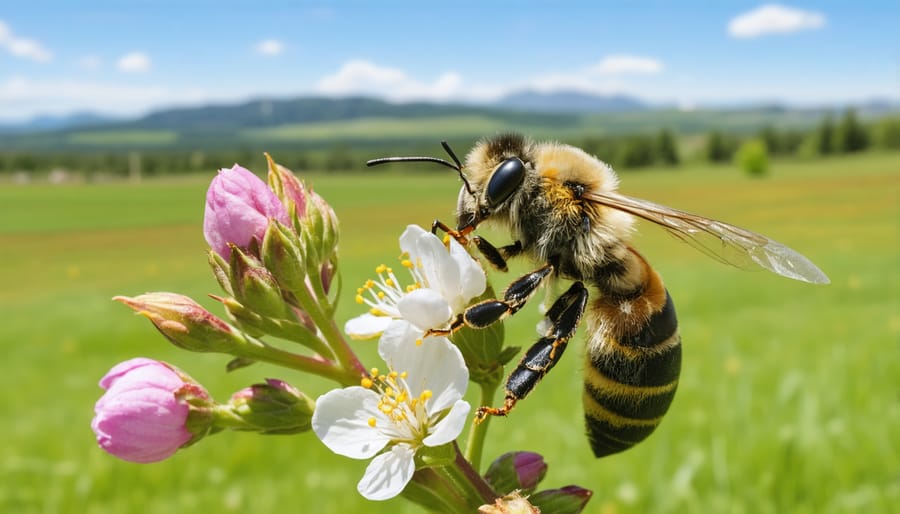
Year-Round Flowering Sequences
In Alberta’s diverse agricultural landscape, strategically planning your tree placement can create a continuous flowering sequence that supports pollinators throughout the growing season. Starting with early-blooming Manitoba maple and willow species in spring, followed by saskatoon berries and chokecherries in late spring, you can establish a reliable foundation for pollinator activity.
Mid-season flowering can be maintained through carefully selected companion plantings. Consider incorporating white spruce and poplar varieties, which not only provide essential windbreaks but also support diverse pollinator populations. Local farmers have reported significant success with staggered planting of caragana and silverberry, which extend flowering periods well into summer.
To maximize year-round benefits, consider creating “pollinator corridors” by connecting different flowering zones across your property. This approach has shown particular success in central Alberta, where farmers have documented increased yields in adjacent crop fields. Many producers combine native flowering trees with fruit-bearing species like Evans cherry and haskap, providing both ecological and economic returns.
For fall flowering sequences, late-blooming species like golden rod and aster can be integrated among your tree stands. This extended flowering period helps support pollinator populations as they prepare for winter, ensuring their return the following spring. Remember to maintain diverse species groups at varying heights, creating multiple canopy layers that offer different flowering times and shelter opportunities.
Economic Benefits of Enhanced Pollination
Increased Crop Yields
Recent studies from Alberta farms have demonstrated impressive increases in crop yields through strategic agroforestry implementation. The Morgan Family Farm near Red Deer reported a 23% increase in canola production after establishing shelterbelts along field margins. Their success stems from improved wind protection and enhanced soil moisture retention, crucial factors in Alberta’s variable climate.
Similar results were observed at the Prairie Heritage Demonstration Farm, where wheat yields increased by 18% in fields adjacent to established tree rows. Farm owner Sarah Thompson notes, “The microclimate created by our agroforestry system has been a game-changer, especially during dry spells.”
When considering economic considerations for agroforestry, these yield improvements significantly offset initial implementation costs. The Lakeland Agricultural Research Association’s three-year study across multiple farms showed average yield increases of 15-25% in various crops, including barley, oats, and pulse crops.
The Wilson Creek Farm provides another compelling example, documenting a 20% increase in forage production for their cattle operation after incorporating silvopasture practices. Their system combines trembling aspen with native grasses, creating beneficial shade areas that promote consistent grass growth throughout the summer months.
These results aren’t just about numbers – they represent real sustainability gains for Alberta farmers. Improved soil health, reduced wind erosion, and enhanced water efficiency all contribute to these yield increases, making agroforestry a practical solution for long-term agricultural productivity in our region.
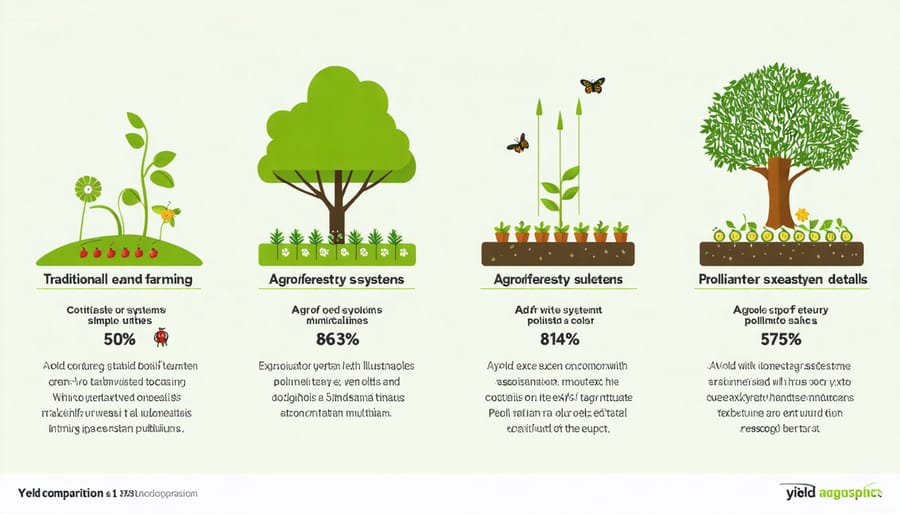
Reduced Pollination Service Costs
One of the most significant economic benefits of agroforestry is the natural reduction in pollination service costs. By incorporating trees and shrubs into your farming system, you create ideal habitats for native pollinators like wild bees, butterflies, and other beneficial insects.
In Alberta, commercial pollination services can cost between $150 to $200 per hive per season. For larger operations requiring multiple hives, these costs add up quickly. However, farmers who have implemented agroforestry systems report up to 60% reduction in their pollination service expenses within three to five years of establishment.
Local farmer Jim Thompson from Red Deer County shares, “Since establishing our shelterbelts and woody buffers eight years ago, we haven’t had to rent any honeybee colonies for our canola fields. The diverse pollinator population does the job naturally.”
The savings extend beyond direct pollination costs. Research from the University of Alberta shows that farms with established agroforestry systems experience more consistent pollination throughout the growing season, leading to improved crop yields and quality. Native pollinators are active earlier in the spring and work in conditions that might deter honey bees, providing more reliable service during challenging weather.
To maximize these benefits, consider incorporating flowering trees and shrubs that bloom at different times throughout the season, creating a continuous nectar source for pollinators.
Implementation Strategies for Canadian Farms
Design Considerations
When designing your agroforestry layout for optimal pollination, proper spacing and arrangement of trees and crops is crucial for success. In Alberta’s climate, we recommend planting trees in north-south rows to maximize sunlight exposure and create beneficial wind patterns that help pollinators navigate between plants.
For tree spacing, maintain 15-20 metres between rows to allow sufficient room for equipment access and to prevent excessive shading of crops. Within rows, space trees 6-8 metres apart to create corridors that guide pollinators through your system while providing them with natural windbreaks and protection.
Consider establishing pollinator-friendly zones every 100-150 metres across your field. These areas should include native flowering plants that bloom throughout the growing season, supporting both wild and managed pollinators. This arrangement also provides integrated pest management benefits by creating habitat for beneficial insects.
When selecting companion crops, arrange them in strips or alleys between tree rows, with taller crops positioned closer to the trees and shorter ones toward the center. This creates a gradual height transition that helps pollinators move efficiently through the system.
Include water sources every 200-300 metres to support pollinator activity, especially during dry periods. Simple features like shallow dishes with stones or small ponds can serve this purpose effectively.
For Alberta’s conditions, we’ve found that incorporating shelterbelts on the north and west sides of the system helps protect pollinators from strong winds while extending their active foraging time. This design approach has shown successful results across various operations in central Alberta, particularly in areas with similar growing conditions to the Red Deer region.

Maintenance Requirements
Maintaining pollinator-supporting trees in your agroforestry system requires consistent but manageable seasonal care. In spring, focus on pruning dead or damaged branches before bud break, typically in early April for most Alberta regions. This promotes healthy growth and ensures adequate sunlight reaches flowering branches. Apply a layer of organic mulch around the base of trees, keeping it about 15 centimetres away from the trunk to prevent moisture-related issues.
Summer maintenance involves regular monitoring for pest issues and ensuring adequate irrigation, especially during dry spells. Most established trees require deep watering every 7-10 days during drought conditions. Consider installing drip irrigation systems to optimize water usage and reduce maintenance time.
Fall care is crucial for winter preparation. Remove fallen fruit and debris that might harbor pests or diseases. Apply compost or well-rotted manure around the root zone to replenish nutrients. In Alberta’s climate, protecting young trees from winter damage is essential – wrap trunks with tree guards to prevent rodent damage and sunscald.
Winter maintenance is minimal but important. Regular inspection for snow and ice damage helps prevent branch breakage. If heavy snow accumulates on branches, gently brush it off to prevent structural damage.
Throughout the year, maintain diverse groundcover between trees to support pollinator habitat. Avoid using chemical pesticides that could harm beneficial insects. Instead, encourage natural pest control by maintaining habitat for beneficial predators.
Remember that different tree species may require specific care. Consult local agricultural extension services for species-specific guidance suited to your region’s unique growing conditions.
Government Support Programs
Alberta farmers interested in establishing agroforestry systems can access various government support programs and financial resources. The Canadian Agricultural Partnership (CAP) offers funding through the Environmental Stewardship and Climate Change Producer Program, providing up to $70,000 per project for eligible agricultural producers implementing sustainable practices.
The Alberta Agroforestry and Woodlot Extension Society (AWES) provides technical support, educational resources, and networking opportunities for farmers transitioning to agroforestry systems. Their mentorship program connects experienced agroforesters with newcomers, offering valuable hands-on guidance and practical advice.
Through Agriculture and Agri-Food Canada’s AgriInnovate Program, producers can access funding for innovative agroforestry projects that enhance environmental sustainability and farm productivity. This program covers up to 50% of eligible project costs, with a maximum contribution of $10 million.
Local Agricultural Service Boards (ASBs) offer additional support through cost-sharing programs for tree planting and shelterbelts. The Alternative Land Use Services (ALUS) program, active in several Alberta counties, provides annual payments to farmers for maintaining ecosystem services on their land, including agroforestry practices.
The Environmental Farm Plan (EFP) program helps farmers assess their environmental risks and opportunities, making them eligible for various funding streams. Completing an EFP is often a prerequisite for accessing other government support programs.
For indigenous agricultural producers, the Indigenous Agriculture and Food Systems Initiative provides specialized funding and support for implementing traditional agroforestry practices while building sustainable food systems.
To access these programs, farmers can contact their local agricultural fieldman or visit their nearest Agriculture and Forestry office for guidance on application processes and eligibility requirements.
Throughout this exploration of agroforestry advantages, we’ve seen how these integrated systems can transform Canadian farmland into more resilient, productive, and sustainable operations. From enhanced soil health and improved water management to increased biodiversity and additional revenue streams, the benefits of agroforestry are both immediate and long-lasting.
For Alberta farmers specifically, the implementation of agroforestry practices offers practical solutions to common challenges like wind erosion, moisture retention, and crop protection. The success stories we’ve shared from local farmers demonstrate that these systems can thrive in our unique climate and soil conditions while providing substantial returns on investment.
The time to embrace agroforestry is now. Climate-smart agriculture isn’t just about environmental stewardship – it’s about building profitable, future-proof farming operations that can weather changing conditions while supporting local ecosystems. By starting small and gradually expanding your agroforestry practices, you can test what works best for your specific situation.
Resources and support are available through local agricultural extension offices, farmer networks, and provincial programs. Consider reaching out to experienced agroforesters in your area or joining a mentorship program to learn from others who have successfully implemented these systems.
Together, we can build a more sustainable agricultural future for Alberta and Canada as a whole. Take the first step today by assessing your land and identifying areas where agroforestry could enhance your farming operation.

